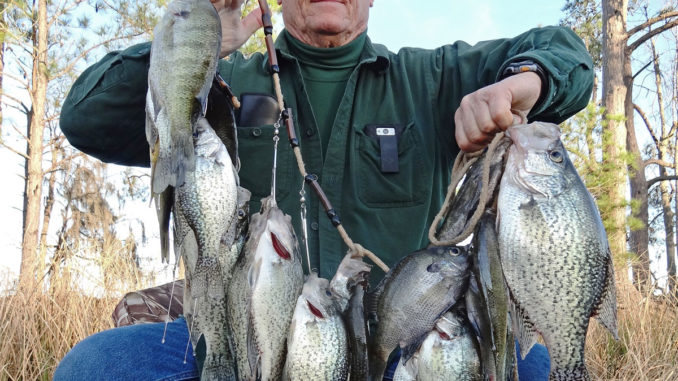
Different species will bite in both reservoirs
January may be the coldest month, but it does put some fish into definable patterns that enable anglers make the most of the cold weather that usually greets the new year. The best action actually begins in the upper end of Lake Marion.
Steve Pack of Pack’s Landing said that January can be an excellent month for crappie fishing and good for largemouth bass in the upper end of Lake Marion and into the swamp.
“Actually, if we have sufficient water — and that appears likely this winter — the crappie will get on a strong bite in January and into February,” Pack said. “The fish will actually begin to move into shallow water in the swamp. They will also be caught in slightly deeper depressions and holes in the upper end of the lake.”
Pack (803-452-5514) said one favored tactic is to take a 1/16-ounce jighead, with a chartreuse, yellow or blue trailer and work it along stumps, logs and other cover in the upper reaches of the lake and swamp. He said when fishing water less than three feet deep he will often put a cork about 18 inches above it and retrieve it with a stop and go retrieve.
“On warmer, cloudy days, we’ll often catch crappie in shallow water in January and even more often during February,” he said. “Many fishermen wait until March for the crappie to bite and miss this action. I prefer jigs most of the time, but live minnows will also work, and if fishing a deeper hole from an anchored boat, it can be even better.”
Pack said bass fishing is good using jigs, spinnerbaits and crankbaits worked slowly around cover 3 to 7 feet deep in the flats and upper end of the lake.
“As with the crappie, this is an overlooked opportunity for many anglers, and again, with the good water levels, the bass will be in fairly shallow water,” he said. “Big bass are usually caught in this part of the lake in January, but we have good fishing for quantity of fish as well. The fishing is usually good throughout the day, so you don’t have to get out at daylight for bass or crappie.”
Pack said some catfish action will be found this month, but that fishing and the best striper fishing typically begins in March.
For the rest of Lake Marion and Lake Moultrie, catfish action is typically very good during January, and good numbers of fish, as well as some huge catfish, are caught.
Guide Alan Spence said the lower end of Lake Marion is a very good spot for blue catfish.
“Catfishing during January can be weather dependant in terms of how the action can be,” he said. “Some days, we’ll catch several fish, and those are usually the cloudy, slightly warmer days before a front. It’s a good time to hook into a big catfish. But the post-frontal days with some wind may be tough for fishermen, but they still offer a reasonably good opportunity to hook into big catfish. Overall, we may not catch as many catfish on a bluebird day, but any January day can produce a big fish.”
Spence (803-478-5029) will look for cormorants and seagulls to find area where forage fish are plentiful; he’ll use his graph to spot where the catfish are holding. He said he often finds them separated a small distance from the big pods of shad. He’ll set up and anchor or tie off to stumps and fan-cast multiple rigs around the boat. He’ll give a spot 45 minutes unless he catching fish.
Spence said striper fishing is also good at times during January, especially early in the month.
“Unless the weather has been real cold, early January is usually good for stripers using live bait, and occasionally for schooling fish in the lower end of the lake,” Spence said. “But once the temperature dips, the action slows on the stripers, but the fishing perks up for the catfish.”
On Lake Moultrie, the striper action is often still very good, especially in the deeper portion near Pinopolis Dam. According to several guides, stripers will congregate primarily because the forage will gang up in deep holes. Stripers will feast on the slower-moving shad in the frigid water, and typically, live bait fished vertically is the best route for consistent catches.
Catfish action is also very good in Lake Moultrie, and it’s tied to the same baitfish schools — menhaden and shad — the stripers are mauling.
One popular method of catching catfish, mostly blue catfish, is to rely on your electronics and fish the big pods of bait as a definable target. When an angler marks big schools of bait on the graph and sees several large, single-fish returns around and under bait, it’s likely big catfish. The shad may be near the surface or very deep, but drop your bait to the depth where big fish are marked. This can be any depth from 20 feet down to 50 feet deep, depending on the forage.
Most guides use a 2-ounce sinker to keep the line vertical and use live or cut gizzard shad, herring or menhaden. A big blue catfish will aggressively take the bait and bury the rod tip about three eyes deep in the water. Protect the rig in a good rodholder or you’ll quickly run out of fishing rods if you lean them against the gunnels.
There’s actually excellent crappie fishing in the main body of Lake Moultrie as well as in the shallow water around the lake during January. Small jigs in the shallows worked around cover will produce slab crappie and big bream and shellcrackers. Jigs or jig-and-minnow combos worked around brush in the main lake will produce quality crappie.





Be the first to comment